Yesterday, the Reserve Bank of Australia finally lowered interest rates some months after it became…
Australia – wages growth remains flat with no household consumption boom in sight
On Wednesday last week (May 19, 2021), the ABS released the latest – Wage Price Index, Australia – for the March-quarter 2021. The WPI data shows that nominal wages growth remains suppressed and workers were able to glean only the most marginal real improvement in purchasing power. Public sector workers endured real wage cuts. The public sector is clearly not demonstrating leadership with their ridiculous wage freezes and wage caps stifling wages growth not only in the public sector but also via the spillover effects to the private sector. Most sectors went backwards in real terms and it was only the annual minimum wage adjustment that saw gains in some sectors – militating against any narrative that suggests that the market is driving inflationary pressures. Not even close.
The summary results (seasonally adjusted) for the March-quarter 2021 were:
- The Wage Price Index grew by 0.6 per cent in the March-quarter 2021 – a static outcome and 1.5 per cent over the previous 12 months.
- The growth for the private sector was 0.6 per cent in the December-quarter and 1.4 per cent over the year – static.
- The growth for the public sector was 0.4 per cent in the December-quarter and 1.5 per cent over the year – slowing.
The Wage Price Index:
… measures changes in the price of labour, unaffected by compositional shifts in the labour force, hours worked or employee characteristics
Thus, it is a cleaner measure of wage movements than say average weekly earnings which can be influenced by compositional shifts.
Nominal wage and real wage trends in Australia
The ABS Media Release – said that:
The … Wage Price Index (WPI) rose 0.6 per cent in March quarter 2021 with the annual growth rate at 1.5 per cent …
The public sector recorded its lowest annual rate of growth (1.5%) since the commencement of the series, while the private sector remained at 1.4% for the second quarter in a row.
The data is summarised by this Table:
| Measure | Quarterly (per cent) | Annual (per cent) |
| Private hourly wages | 0.6 | 1.6 |
| Public hourly wages | 0.4 | 1.5 |
| Total hourly wages | 0.6 | 1.6 |
| Basic CPI measure | 0.5 | 1.0 |
| Weighted median | 0.4 | 1.3 |
| Trimmed mean | 0.3 | 1.1 |
Which means that real wages were basically flat over the March-quarter (using the general CPI measure) in the private sector but public sector workers went backwards (as a result of the wage caps).
The public sector wage caps (state and federal) are creating an environment where private sector wage rises are being constrained.
Over the year, there has been only slight increases in real wages and productivity growth was stronger (1.9 per cent over the year), which means that national income was redistributed to profits away from wages.
On price inflation measures, please read my blog – Inflation benign in Australia with plenty of scope for fiscal expansion – for more discussion on the various measures of inflation that the RBA uses – CPI, weighted median and the trimmed mean The latter two aim to strip volatility out of the raw CPI series and give a better measure of underlying inflation.
The first graph shows the growth in private sector real wages since the March-quarter 2005 to the March-quarter 2021. The Core inflation measure excluding volatile items is used.
The blue bars are the annual rate of change, while the red line is the quarterly rate of change.
The fluctuation between the June- and September-quarters 2020 is an outlier created by the temporary government decision to offer free child care for the June-quarter which was rescinded in the September-quarter.
Overall, the record since 2013 has been appalling.
Throughout 2017 and into 2018, real wages growth was negative. But then there were several quarters of modest real wages growth. The trend, however, is towards zero real wages growth.
The next graph shows the overall annual growth in the Wage Price Index (public and private) since the December-quarter 2000 (the series was first published in the December-quarter 1997).
I also superimposed the RBA’s core annual inflation rate (red line). The blue bar area above the red line indicate real wages growth and below the opposite.
If you then think about the RBA’s claimed strategy to get annual inflation back into its targetting range (2 to 3 per cent) and the fact that nominal wages growth has been nowhere near that you will understand that there is a significant real wage cutting strategy in place, which makes it almost impossible for consumption growth to be as robust as the Government is projecting, once we take into account the record levels of household debt and the declining rate of growth in household consumption spending prior to the pandemic.
Sectoral Variability
The aggregate data shown above hides quite a significant disparity in quarterly wage movements at the sectoral level, which are depicted in the next graph.
The blue bars are the current quarterly change, while the red triangles are the previous quarterly change.
Nine of the 18 sectors in the ABS classification went backwards.
The ABS also reported that:
– Accommodation and food services recorded the highest quarterly rise of 1.2%. The main driver of the industry’s wages growth were increases to award and award-reliant jobs influenced by the FWC decision.
– Electricity, gas, water and waste services, Rental, hiring and real estate services and Arts and recreation services each recorded the lowest quarterly rise of 0.1%. The Rental, hiring and real estate services industry also recorded the lowest annual rise of 0.4%.
– Education and training recorded the highest annual rise of 2.2%.
– All industries recorded lower annual wage growth than the year before.
So the strongest growth was not ‘market’ driven but the result of adjustments to the minimum wage by our tribunal system and the flow-ons that occurred after that.
If we consider the situation over the last year then we can see from the following graph that growth in 12 of the 18 sectors has gone backwards, with 3 marking time.
Overall, growth is now lower than it was a year ago.
The last two quarters have not quite got workers back to where they were a year ago.
While nominal wages growth was mostly positive, albeit modest, the next graph shows the movements in real wages and you can see that workers in all occupational groups bar Accommodation and food services, Education and training, and Health care and social assistance, lost purchasing power in the March-quarter.
Overwhelmingly, the consecutive real wage cuts presents a very bleak outlook and casts doubt on the Federal governments fiscal strategy which is relying on a strong
Workers not sharing in productivity growth
The Non-farm GDP per hour data (productivity) is derived from the quarterly National Accounts and available via the RBA Table H2 Labour Costs and Productivity.
The ABS Information Note: Gross Domestic Product Per Hour Worked – says that:
In Australian National Accounts: National Income, Expenditure and Product (cat. no. 5206.0) and Australian System of National Accounts (cat. no. 5204.0) the term ‘GDP per hour worked’ (and similar terminology for the industry statistics) is generally used in preference to ‘labour productivity’ because:
– the term is more self-explanatory; and
– the measure does not attribute change in GDP to specific factors of production.
While real wages growth means that the rate of growth in nominal wages is outstripping the inflation rate, another relationship that is important is the relative growth of real wages and productivity.
Historically (for periods which data is available), rising productivity growth was shared out to workers in the form of improvements in real living standards.
In effect, productivity growth provides the ‘space’ for nominal wages to growth without promoting cost-push inflationary pressures.
There is also an equity construct that is important – if real wages are keeping pace with productivity growth then the share of wages in national income remains constant.
Further, higher rates of spending driven by the real wages growth then spawned new activity and jobs, which absorbed the workers lost to the productivity growth elsewhere in the economy.
Taking a longer view, the following graph shows the total hourly rates of pay in the private sector in real terms (deflated with the CPI) (blue line) from the inception of the Wage Price Index (December-quarter 1997) and the real GDP per hour worked (from the national accounts) (green line) to the March-quarter 2021.
It doesn’t make much difference which deflator is used to adjust the nominal hourly WPI series. Nor does it matter much if we used the national accounts measure of wages.
But, over the time shown, the real hourly wage index has grown by 13.4 per cent, while the hourly productivity index has grown by 36 per cent.
So not only did real wages decline in the December-quarter, the growth in productivity widened the gap between the two series even further.
If I started the index in the early 1980s, when the gap between the two really started to open up, the gap would be much greater. Data discontinuities however prevent a concise graph of this type being provided at this stage.
For more analysis of why the gap represents a shift in national income shares and why it matters, please read the blog post – Australia – stagnant wages growth continues (August 17, 2016).
Where does the real income that the workers lose by being unable to gain real wages growth in line with productivity growth go?
Answer: Mostly to profits.
The next graph shows the grap between the real wage index and the labour productivity index in points.
It is the cumulative redistribution of income to profits.
Now, if you think the analysis is skewed because I used GDP per hour worked (a very clean measure from the national accounts), which is not exactly the same measure as labour productivity, then consider the next graph.
It shows the movements in the wage share in GDP (at factor cost) since the March-quarter 1960 to the September-quarter 2020.
The only way that the wage share can fall like this, systematically, over time, is if there has been a redistribution of national income away from labour.
I considered these questions in a more detailed way in this blog post series:
1. Puzzle: Has real wages growth outstripped productivity growth or not? – Part 1 (November 20, 2019).
2. 1. Puzzle: Has real wages growth outstripped productivity growth or not? – Part 2 (November 21, 2019).
And the only way that can occur is if the growth in real wages is lower than the growth in labour productivity.
That has clearly been the case since the late 1980s. In the March-quarter 1991, the wage share was 56.6 per cent and the profit share was 22.2 per cent.
By the September-quarter 2020, the wage share had fallen to 49 per cent and the profit share risen to 31.1 per cent.
In the December-quarter, the wage share had risen slightly to 50.9 per cent, but the latest wage data suggests that the increase will evaporate in the March-quarter when that data is released next week.
At any rate, a massive redistribution of income towards profits has occurred over the last 40 years.
The relationship between real wages and productivity growth also has bearing on the balance sheets of households.
One of the salient features of the neo-liberal era has been the on-going redistribution of national income to profits away from wages. This feature is present in many nations.
The suppression of real wages growth has been a deliberate strategy of business firms, exploiting the entrenched unemployment and rising underemployment over the last two or three decades.
The aspirations of capital have been aided and abetted by a sequence of ‘pro-business’ governments who have introduced harsh industrial relations legislation to reduce the trade unions’ ability to achieve wage gains for their members. The casualisation of the labour market has also contributed to the suppression.
The so-called ‘free trade’ agreements have also contributed to this trend.
I consider the implications of that dynamic in this blog post – The origins of the economic crisis (February 16, 2009).
As you will see, I argue that without fundamental change in the way governments approach wage determination, the world economies will remain prone to crises.
In summary, the substantial redistribution of national income towards capital over the last 30 years has undermined the capacity of households to maintain consumption growth without recourse to debt.
One of the reasons that household debt levels are now at record levels is that real wages have lagged behind productivity growth and households have resorted to increased credit to maintain their consumption levels, a trend exacerbated by the financial deregulation and lax oversight of the financial sector.
Real wages growth and employment
The standard mainstream argument is that unemployment is a result of excessive real wages and moderating real wages should drive stronger employment growth.
As Keynes and many others have shown – wages have two aspects:
First, they add to unit costs, although by how much is moot, given that there is strong evidence that higher wages motivate higher productivity, which offsets the impact of the wage rises on unit costs.
Second, they add to income and consumption expenditure is directly related to the income that workers receive.
So it is not obvious that higher real wages undermine total spending in the economy. Employment growth is a direct function of spending and cutting real wages will only increase employment if you can argue (and show) that it increases spending and reduces the desire to save.
There is no evidence to suggest that would be the case.
The following graph shows the annual growth in real wages (horizontal axis) and the quarterly change in total employment (vertical axis). The period is from the December-quarter 1998 to the March-quarter 2021. The solid line is a simple linear regression.
Conclusion: When real wages grow faster so does employment although from a two-dimensional graph causality is impossible to determine.
However, there is strong evidence that both employment growth and real wages growth respond positively to total spending growth and increasing economic activity. That evidence supports the positive relationship between real wages growth and employment growth.
Noting that we should not draw causality from two-dimensional cross plots.
Conclusion
In the March-quarter 2021, Australia’s wage growth continued to struggle at record low levels.
There can be no sustained recovery for the economy post Covid without a significant shift in the way we think about wages growth.
The business sector, as a whole, thinks it is clever to always oppose wages growth and the banks love that because they can foist more debt onto households to maintain their consumption expenditure.
But the wheels are falling off the whole show and the pre-Covid imbalances between wages and profits have not been addressed.
The problem is that the federal government supports wage suppression because that attracts funding for the conservatives from the corporate lobbies which help them stay in power.
It is a pretty bleak outlook for workers.
That is enough for today!
(c) Copyright 2021 William Mitchell. All Rights Reserved.
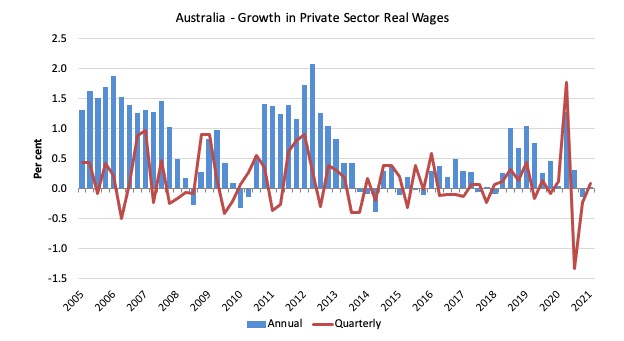
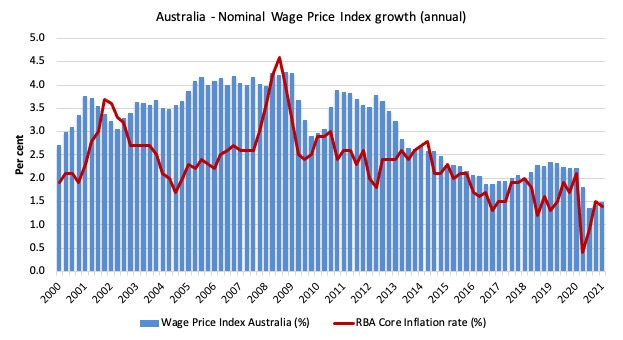
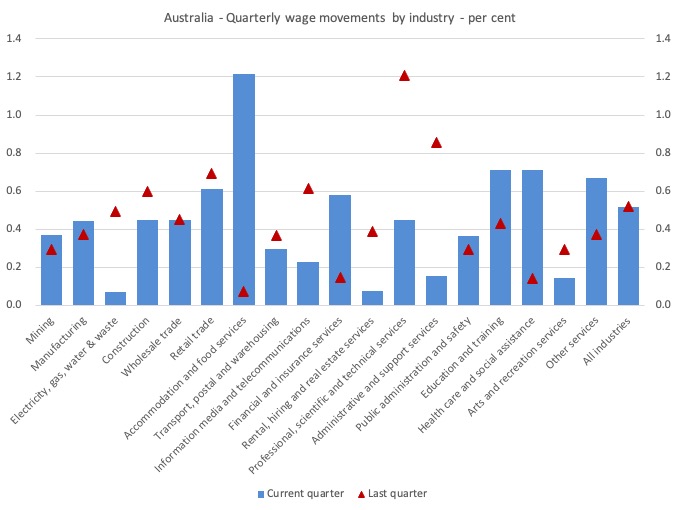
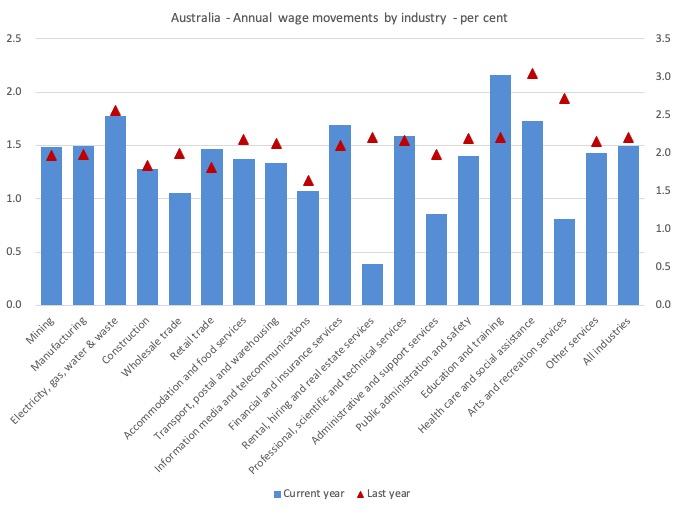
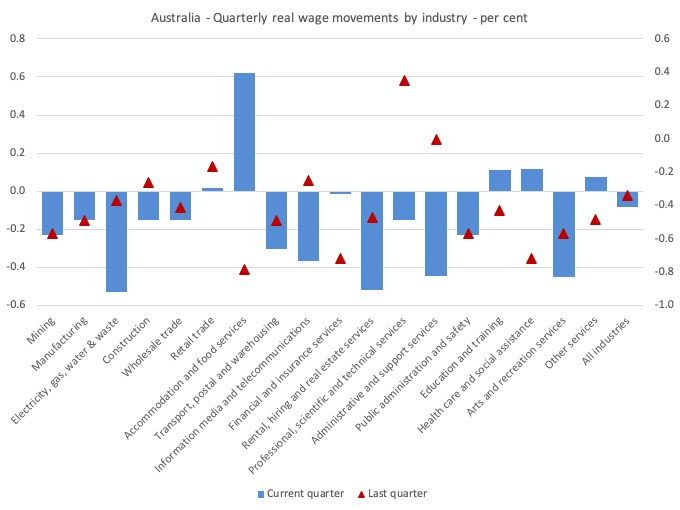

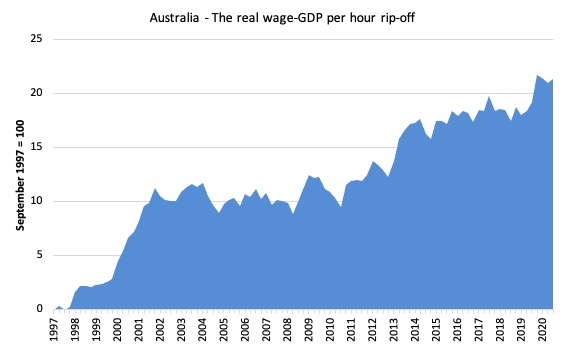
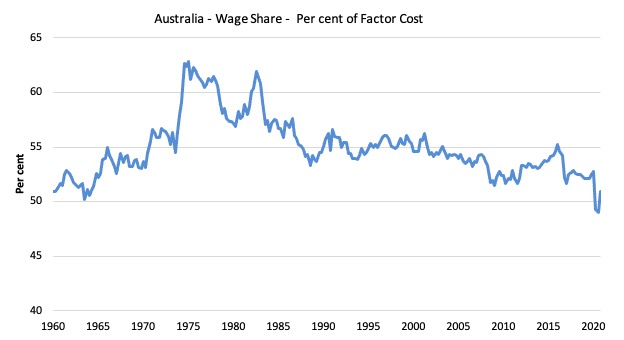

Great post. Every union official in Australia should read it. I have shared it with union officials I know and encourage others to do the same.
We are now setlling back in to the slow GDP growth, slow wage growth rut we were in pre COVID and the fiscal bailout/stimulus. I have labelled this phenomemon ‘stagtration’: economic torpor caused by upwards concentration of wealth & income/strangling of working and middle class consumption.
One way to address this now is through state and federal public sector wage agreements that give substantial real increases. These can be funded through federal deficits/Reserve bond buying.
As well as having its own effect on spending and growth this will put pressure on private sector employers to cough up.
The current formulation has workers waiting for private sector wages to rise due to market forces and then raising them in the public sector to match….Godot will turn up before that happens.
I want to thank you for the section towards the end of the post titled “Real wages growth and employment”. It answers many of my questions about one particular Quiz Question (for example, question 2 on the May 15-16, 2021 answers and discussion). That it is almost completely at odds with the reasoning given for the recommended answer for that question does not trouble me at all- since I have the feeling that what you wrote today more truly reflects your opinion regarding rising real wages. Yes, I am sure there are some nuances that make it theoretically possible that rising real wages could cause mass unemployment given some combination of unlikely assumptions turning out to be true. Just like occasionally you might win some lottery when the odds are thousands to one against it happening.
Well anyways- thank you for this explanation.